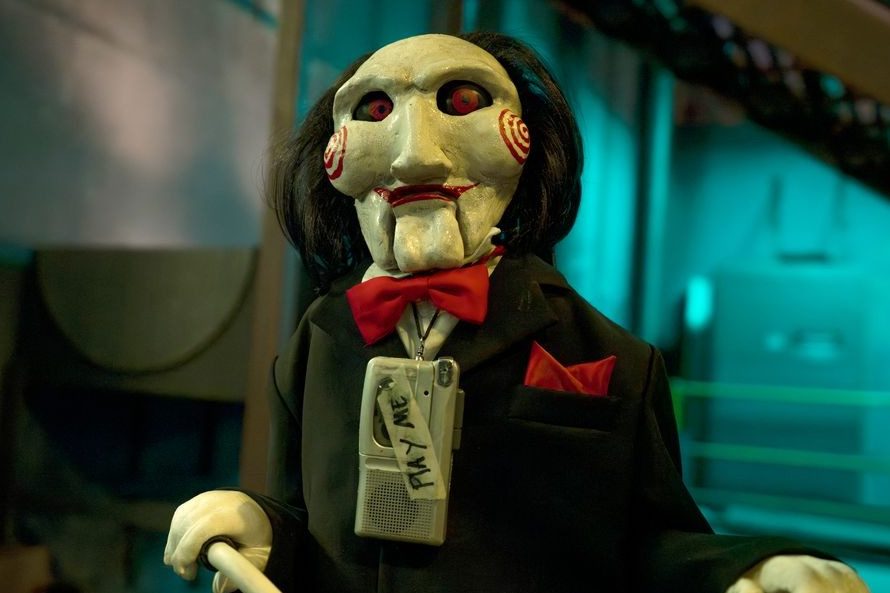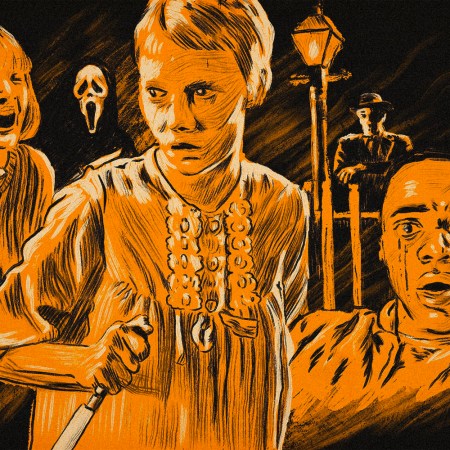Even if you haven’t got an appendage strapped into one of his spring-loaded doohickeys of death, you’ve got to hand it to Jigsaw: he understands that if you love what you do, you’ll never work a day in your life. Retired following a career as an architect and civil engineer — presumably a pretty successful one, considering the budgetary demands of his golden-years avocation — the man born John Kramer fills his days by putting his skills to good use on personal passion projects with a panache betraying their creator’s pride. It would be easy enough for him to simplify his Hobson’s choice between self-torture or fatality to a more efficient, straightforward process, but he can’t resist an elaborate theatricality in his feats of planning and logistics. Any rank amateur can break someone’s kneecaps or dislocate their arm. It takes a true artist to dream up a device allowing a user to snap their individual fingers with each notch of a dial against a ticking countdown, on penalty of their eyeballs getting shlorped out by a pair of pressurized pneumatic tubes. Why else bother with the puppet and trike?
And yet for all the apparent gratification Kramer gets from his grisly hobby, he insists that it’s strictly business. He’s on a mission of mercy, as he has laboriously explained over and over again throughout the 10 installments of the Saw franchise. He singles out bad people, in the hopes that subjecting them to extreme torment will help them see the error of their ways and return to society with a new lease on life, should they survive their trial. In his assessments of evil, he paints with a pretty broad brush in high-contrast black and white, inflicting the same agonies on corrupt cops and killers as a drug addict guilty only of harming themselves. The logic behind all this is shaky at best; it’s tough to imagine anyone emerging from this gauntlet of grievous physical injury and psychological trauma better off, lone victor Amanda Young having been mentally unlaced by these sick games. Still, Kramer repeatedly shrugs off his complicity in his own spectacles with the rationale that he’s merely standing by and watching as his victims decide their own fate. The guy’s not chanting “stop mutilating yourself, stop mutilating yourself!” from his observation box control room, but even so, this does not seem meaningfully different from firing a gun and challenging your target not to get shot.
This contradiction between the self-evident love of violence and the flimsy effort to justify it under a higher purpose can be extrapolated from villain-turned-protagonist Kramer to the series itself, in particular the latest installment Saw X. In this sequel/prequel wedged between the first and second films — offing the fan-favorite character at the end of Saw III forced the timeline into absurdly convoluted contortions just to keep him around — a cancer-stricken Kramer goes down ol’ Mexico way for a radical battery of treatment not yet legal in the States, only to wake up with tumors intact and short a quarter-million dollars. His hunger for revenge dovetails nicely with his program of perverse salvation, and before you can say “acute radiation poisoning cannon,” the responsible parties have been convened in a warehouse and shackled to his diabolical contraptions. While locked in one such murder machine, their leader Cecilia Pederson lobs an insult deployed less often around these parts than sadist or monster, an epithet that strikes a chord for its grain of truth: hypocrite.
The inaugural Saw arrived in 2004, a Sundance crowd-pleaser that came to theaters four days before the American people reelected George W. Bush for a second presidential term. At the time, critics and pundits theorized a connection between the two, that the hideous national impulse behind the photos leaked from Abu Ghraib earlier that year had been laundered through a film stylizing such human rights violations as entertainment. Those using the term “torture porn” meant it as a diss, a way to write off a new movement in hardcore grotesquerie as a tawdry delivery service for cheap thrills. But like such value-neutral classifications as food porn or actual porn, this microgenre caters to a fundamental biological drive by providing a stimulating outlet for pent-up animus. Uncomfortable as they may be to admit it, people gravitate toward fucked-up shit, made clear by the spike in popularity for true crime content that excuses its gawking at real suffering under the pretense of investigation; at least Saw is honest about the indulgence it offers.
As if blowing a raspberry back at the tongue-cluckers of the mid-aughts, the grand finale of Saw X meets the War on Terror reading head-on with a grueling double waterboarding beneath torrents of blood. Just as a musical lives and dies by its production numbers, torture porn exists for the sake of these hysterically cathartic displays of rousing disfigurement, sacrifices of flesh atop the altar of pop culture. That imperative to simple pleasure fights an inferiority complex of legitimacy that has spread throughout horror in the past couple decades, leading those with artistic aspirations to distance themselves from the pack through the nonsense label of “elevated horror.” Not even Saw, reviled and reputed as the grimiest scraper of the barrel’s bottom, is immune to this line of confused thinking.
“Barbarian” Offers a Delightful Twist on Horror Movie Conventions
The tale of an Airbnb rental gone wrong has plenty of tricks up its sleeveJust shy of two hours, the tenth chapter in the so-called “Book of Saw” runs the longest yet by a healthy margin, because “we needed the time to care not only about John, but to care about all the other actors,” as the producers have explained. With but a single kill to perk things up, the first half-hour slows to a lugubrious crawl as what should be expository setup wallows in Kramer’s misfortune. He claims that he has much to do in his limited time left, though that doesn’t stop writers Peter Goldfinger and Josh Stolberg from frittering lots of it away on tiresome character development, in particular Kramer’s weirdly paternal bond with a local kid playing soccer against the wall of the sham facility. Series pinnacle Saw II populated its booby-trapped house with functional sketches, their usefulness confined to how their one-line backstories linked this ensemble and marked them for death. Saw X frames Kramer like a tragic hero instead of a complete maniac with a thing for Rube Goldberg homicide, and swears by the wobbly moral mechanism he believes will balance his soul’s ledger.
Earlier parts of the Saw saga have flirted with the notion of being about something more than the joy of harm, with damning takes on police brutality (as in Spiral), tabloid celebrity (as in Saw 3D), and most fumblingly, America’s contemptible healthcare system and housing market (as in Saw VI). Such preoccupations tend to get in the way of the gory raison d’etre rather than enhance it, and in the case of Saw X, they leave fat on the bone that a stronger edit would’ve flensed away. There’s a fascinating, frustrating tension between the movie the Saws want to be and the movie they’re meant to be, reflective of a wider ambivalence between the audience’s craving for carnage and the guilt we assume we should feel for it. But Jigsaw doles out more than enough pain to go around without his starring vehicles punishing their viewership or themselves. As he knows all too well, the work is its own reward.
This article was featured in the InsideHook newsletter. Sign up now.

























